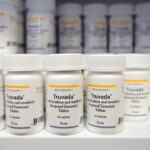Research shows that despite scientific research on human immunodeficiency virus (HIV) and availability of medical treatments, stigma and discrimination tends to be one of the biggest barriers to seeking HIV care.
You may be contributing to HIV stigma ― negative attitudes, behaviors and judgments towards people living with or at risk of HIV ― without being aware of it.
“Stigma spreads infectious diseases, full stop,” said Dr. Megan Coffee, an assistant professor of population and family health at Columbia University’s Mailman School of Public Health.
Stigma and discrimination can also negatively affect the mental health of people living with HIV if they are discouraged from learning their HIV status, accessing treatment, or staying in care.
“The words that we use and the shame that our society inflicts upon people with HIV can cause serious outcomes in terms of worsening their mental health and emotional well-being,” said Dr. Chase Anderson, an assistant professor of psychiatry at the University of California San Francisco.
HuffPost spoke to experts about common HIV stigmas that are perpetuated in today’s society. Here are some common ways you may be contributing to HIV stigma unknowingly:
You refer to someone as “HIV positive.”
Calling someone “HIV positive” stigmatizes the disease and segregates them as an outsider.
“HIV is treated using a group of medications called antiretrovirals and, because there is currently no cure or vaccine for HIV, treatment is lifelong,” said Dr. Jaimie Meyer, an infectious disease physician and associate professor of medicine at Yale School of Medicine.
Instead of saying that someone is “HIV positive,” use language like “living with HIV.”
You believe that only certain groups of people can be diagnosed with HIV.
By believing only certain groups of people can be diagnosed with HIV, it can distort your views of HIV, leading to racism and homophobia. It can also drive denial that you can never get diagnosed or transmit HIV yourself.
“[You think] it’s ‘other’ people who have a disease, not us. It can be a mental distancing, a way to put what is painful out of sight, out of mind,” Coffee said.
Even though the majority of HIV infections in the U.S. are among people with male sex assigned at birth, and Black people are disproportionately affected by HIV, it can affect anyone, Meyer said.
“HIV is primarily transmitted through sex, and receptive anal sex carries the highest risk. It is also transmitted through injection drug use, especially when people share needles, syringes or other injecting equipment that may have traces of blood left behind,” Meyer said.
You believe HIV cannot be prevented.
There are a variety of methods for HIV prevention and should be widely shared to increase awareness and accessibility. Due to the work of HIV activists, as well as clinicians and researchers, it has taken decades to transform HIV prevention care.
PrEP, known as pre-exposure prophylaxis, is a medication used by people without HIV who are at risk of being exposed to HIV through sex or injection drug use. If someone is exposed to HIV, having the PrEP medicine in the bloodstream can stop HIV from spreading throughout the body.
“More recently, PrEP has made a huge difference. It has brought people into clinics, who might have felt too young and healthy to need to go, or who might have felt they would not have been welcomed. It has also brought speaking openly about sex and sexuality into more and more patient-clinician conversations,” Coffee said.
Meyer added that people can also prevent the onward transmission of HIV by using barrier protection, like condoms and dental dams, which can be effective when used correctly.
You believe HIV cannot be treated.
While HIV is not yet fully curable, it is manageable with medications, Coffee noted.
People getting treated for HIV take a group of medications called antiretrovirals for life. Some may take it through a daily pill and some may get an alternative injectable treatment regimen that is given once every two months in a doctor’s office.
While getting treatment doesn’t mean the virus goes away ― just that it is being suppressed by medications ― once someone’s viral load is undetectable, they cannot transmit the virus on to others, Meyer said.
Believing that HIV cannot be treated perpetuates stigma around interacting with people living with HIV with the false fear that they still may be able to transmit the virus.
“Getting on treatment should be empowering. We want people with HIV to go on to live happy healthy lives, which may include healthy sex lives and having children free from HIV,” Meyer said.
You avoid discussing HIV prevention and care.
Avoiding conversations about HIV further creates a societal taboo and prevents people from getting tested or seeking care they need.
According to the Centers for Disease Control and Prevention, 80% of new HIV infections are transmitted by people who don’t know they have the virus or are not receiving any care.
“People still exist with fear that they will be discriminated against, judged, and lose family members and connections if their HIV status is revealed. We need to be talking about how the virus is transmitted and openly discussing the societal stigma that precludes people from having these conversations,” Anderson said.
Educate yourself on HIV, and foster open dialogue around prevention and care. Not only will this destigmatize HIV, but also create a supportive space for people living with or at risk of HIV.
“I know to expect stigma and that it can affect anyone, but what still hits me hard is that those who care for and counsel those with HIV may be affected by the very same stigma and denial they fight against,” Coffee explained. “It’s a painful reminder we are all human, all affected by stigma and denial.”


